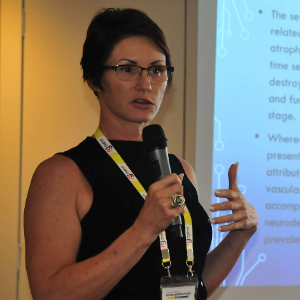Title : Isometric exercise training for managing vascular risk factors in mild cognitive impairment and alzheimer’s disease
Abstract:
Pathological changes to the cerebral microvasculature precede and/or accompany vascular disorders such as hypertension, neurovascular disorders such as AD, and cognitive decline.Individuals with a history of vascular risk factors (VRF’s) and vascular disease are considered high risk candidates for developing cognitive impairment in later life. Evidence suggests that vascular injury exacerbates the severity of dementia in AD and that the neurodegenerative process is heavily driven by vascular factors. Data from recent analyses suggests that isometric exercise training (IET) may improve vascular integrity and elicit blood pressure reductions in hypertensives greater than those seen with dynamic aerobic and resistance exercise. Unlike aerobic exercise, the effects of IET on cognitive performance have not been investigated. Supporting a proposition that IET performed by elderly individuals might promote healthy neural functioning and boost cognitive performance are the same principles that support the efficacy of remote ischemic conditioning (RIC) and physiological ischemic training (PIT). Ischemic conditioning of a healthy limb to stimulate endogenous protective pathways to support and improve the healthy functioning of distant organs such as the kidneys, heart and the brain has been successfully demonstrated through blood restriction techniques such as remote ischemic conditioning (RIC) and physiological ischemic training (PIT). Originally ischemic conditioning was developed as a cardio protective technique for patients with cardiovascular arterial disease and myocardial ischemia, however, current research demonstrates that similar to the heart, the brain can also be conditioned with ischemia and hypoxia. RIC has been demonstrated to stimulate endogenous neuroprotectivepathways and increase cerebral blood flow. Mouse models of vascular cognitive impairment show that when compared to the control cohort, RIC resulted in less inflammation, less β-amyloid deposition, reduced white and grey matter damage, increased cerebral blood flow and improved cognition. Furthermore, RIC has also been implicated in enhancing neuroplasticity. PIT is a technique whereby skeletal muscle is subjected to intense contraction via isometric contraction or tourniquet in order to stimulate physiological ischemia. In clinical trials, PIT using isometric handgrip exercise performed by patients with coronary artery disease and a coronary artery occlusion significantly increased collateral blood flow in the myocardium. Unlike RIC, the efficacy of PIT to neural applications has not yet been investigated. Most encouraging is the potential neuroprotective implications that ischemic training may offer those with mild cognitive impairment (MCI), AD, and vascular dementia. Whilst the protocols between RIC and PIT differ from each other and the extent of commonality of the signalling and protective mechanisms involved is still the subject of investigation, both of these techniques involve the activation of endogenous signalling and protective pathways and, according to recent literature, also appear to engage some shared mechanisms. Encouragingly RIC administered to patients aged 80 to 95 years old with intracranial atherosclerosis stenosis was found to be both safe and effective in stroke prevention and treatment and IET has been safely implemented among a cohort of hypertensive elderly women, 70 to 82 years old. Moreover, the principles that support the efficacy of RIC and PIT also support the feasibility of a hypothesis that IET performed by elderly individuals might promote healthy neural functioning and boost cognitive performance. It may be that IET might have the capacity to play an effective role in the management of VRF’s at the MCI stage of AD and may prove to be a significant strategy in the prevention, attenuation or delay of progression to AD.




